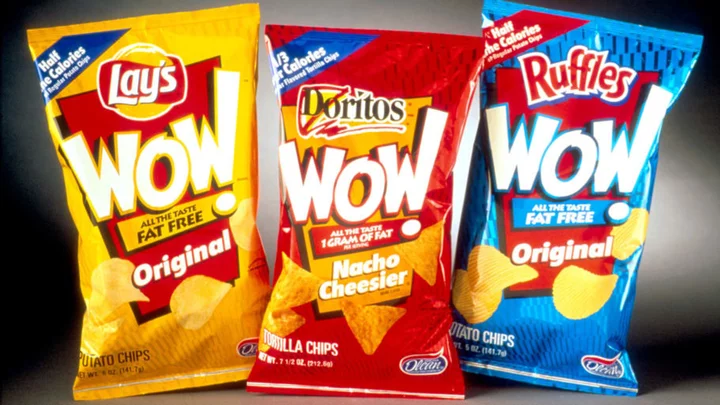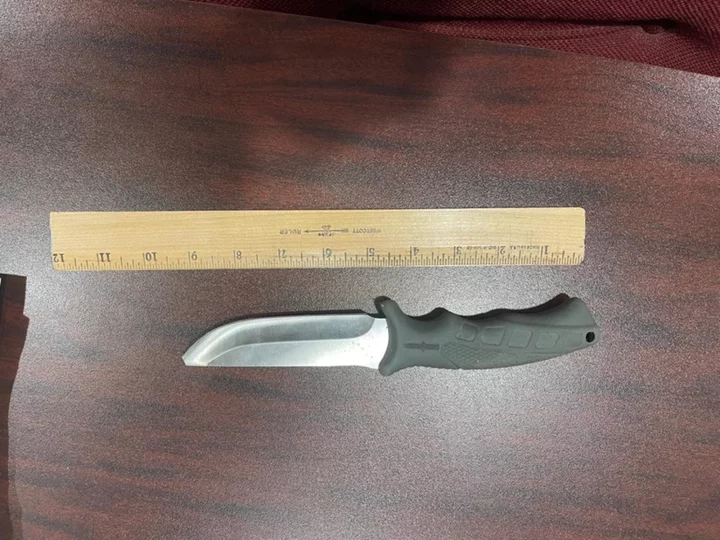When Procter & Gamble began market-testing a fat-free version of their popular Pringles snack in late 1996, Pringles brand manager Casey Keller called their attempt to revolutionize the food industry with the calorie-conscious chips “the number-one unmet consumer need” of the moment.
The chip, which had zero grams of fat and only half the calories of conventional Pringles, was made possible by Procter & Gamble’s olestra, a synthetic fat molecule marketed under the brand name Olean. Because it was too large to be absorbed by the intestine, it passed through the digestive tract—a little too quickly, as it turned out.
Olestra, which was found in Pringles and later in Frito-Lay products like Ruffles and Doritos, was burdened by a nagging problem. The miraculous fat molecule gave a percentage of consumers stomach cramps, loose bowel movements, and diarrhea. It also led to the coining of phrases not normally associated with snack foods, like “fecal urgency” and “anal leakage.”
A 25-Year-Long Journey
Olestra’s origins date back to 1968, when Procter and Gamble researchers were investigating fats that premature infants might be able to tolerate more easily. Over time, they found that attaching an increased number of fatty acids to the sorbitol molecule rendered the fats unable to pass through the mucus membrane of the intestine and were therefore totally indigestible.
Because sorbitol was expensive, researchers substituted sucrose and combined it with triglycerides. With this “fake” fat derived from cottonseed and soybean oils, they seemed to have discovered the holy grail of satiety: a greasy additive that provided flavor with zero calories, zero fat, and zero cholesterol.
The development process took 15 years. It took another 10 years for the Food and Drug Administration (FDA) to approve olestra for the so-called savory food category: potato chips, pretzels, and other salty snacks—but there were a few wrinkles. For one, olestra appeared to affect how the body absorbed vitamins A, E, D, and K. It also impacted dietary carotenoids, which may help the body ward off cancer and heart disease. The FDA insisted snacks made with olestra be supplemented with vitamins to offset any imbalance that ingestion might cause. The agency also mandated a package warning about abdominal cramping and loose stools, an observed side effect of olestra consumption.
Procter & Gamble made a minor stir about the label—after all, it can be difficult to market food with a warning that it might give you explosive diarrhea—but was otherwise pleased. After 25 years and an estimated $200 million in development costs, olestra was finally ready for store shelves.
Procter & Gamble started with Pringles, test marketing a fat-free version of the baked chips in Ohio in 1996. As the company was prepared to sell the ingredient to other snack companies, Frito-Lay began experimenting with it in Lay’s, Ruffles, Tostitos, and Doritos that same year. Early word was encouraging, and all products went on to a national rollout in 1998.
Something’s Stirring
For a public weaned on the idea that dietary fats were bad, olestra caused a huge stir. Frito-Lay, which marketed the chips under the brand name Wow!, pushed the idea that the chips had just 75 calories per serving, half the calories of the regular recipe, and no fat instead of the 10 grams typical of chips. That the snacks could conceivably create bathroom emergencies was relegated to late-night talk show jokes. Procter & Gamble largely dismissed the claims, comparing the potential gastrointestinal distress of olestra to eating beans or broccoli.
But broccoli had never been demonstrated to cause an orange-yellow liquid to seep out of one’s rear end. The FDA and Procter & Gamble were inundated with 16,700 complaints from consumers that products made with olestra were giving them problems from flatulence to stained underwear. A meeting of Washington’s Center for Science in the Public Interest, which had criticized Procter & Gamble for hyping olestra, featured video testimony of people afflicted by the molecule. One claimed the cramps of snacking were comparable to the early stages of labor.
Other experiences with olestra were said to include the passing of orange-yellow “globules” of oil as well as difficulty wiping. The Center even shared a study commissioned by Frito-Lay which was meant to be confidential that demonstrated “anal oil leakage” was experienced by 3 to 9 percent of study subjects. “Underwear spotting” was present in 5 percent. A variety of gastrointestinal issues were observed in 7 percent.
The potential for leakage aside, olestra overcame much of its bad publicity. Frito-Lay sold $347 million in Wow! chips in 1998 alone. The fat-free Pringles were good for $100 million that same year. It appeared that consumers were sufficiently enticed by a lower-calorie option that they wanted to see how olestra would affect them first-hand.
High Hopes and Loose Stool
It’s impossible to know what percentage of consumers experienced adverse effects. But it’s not hard to see why it could have proven so problematic. Unlike the practical serving sizes eaten in studies, consumers tend to binge on chips, devouring a bag at a time or in conjunction with other food. While Procter & Gamble admonished that chips were snacks, it was hard to dissuade people from seeing a bag of chips with half the calories and eating the entire thing. Even Procter & Gamble admitted that gorging could give you loose stools and cramping.
Procter & Gamble had high hopes for olestra, projecting $1 billion in sales in 2000 and eventually an entire line of olestra-infused goods like salad dressings and desserts. But two years after its explosively profitable debut, sales were just half that, and only a few other companies like Utz and Herr’s used olestra in their products. Even after the FDA removed the label warning requirement in 2003, consumers weren’t finding runny stool all that appetizing.
Frito-Lay renamed their Wow! chips to Ruffles Light and Doritos Light in 2004. In 2009, Procter & Gamble made olestra an additive in eco-friendly paints and lubricants. Some foods are still made with olestra, though it’s no longer the industry disruptor the company had hoped for.
Speaking of its potential in 1998, Procter & Gamble’s then-chairman and chief executive John E. Pepper, Jr. believed that olestra could soon take a place of prominence among other Procter & Gamble products, like Pampers diapers. He did not mention whether he expected sales of the former would help sales of the latter.
A version of this story originally ran in 2020; it has been updated for 2023.
This article was originally published on www.mentalfloss.com as May Cause Anal Leakage: The Olestra Fat-Free Snack Controversy of the 1990s.









